HP Spectre XT TouchSmart Ultrabook Review
by Dustin Sklavos on May 27, 2013 5:00 AM EST- Posted in
- Laptops
- HP
- Ivy Bridge
- Spectre
- Ultrabook
Display Quality
While I'm overjoyed to be getting a series of notebooks in featuring panels with decent resolution and quality, I remain at least a little mystified by the IPS panels used in the Mythlogic Callisto 1512 recently reviewed and now the one in HP's Spectre XT TouchSmart. You'll see that while contrast and brightness are both excellent, color gamut is unusually low.
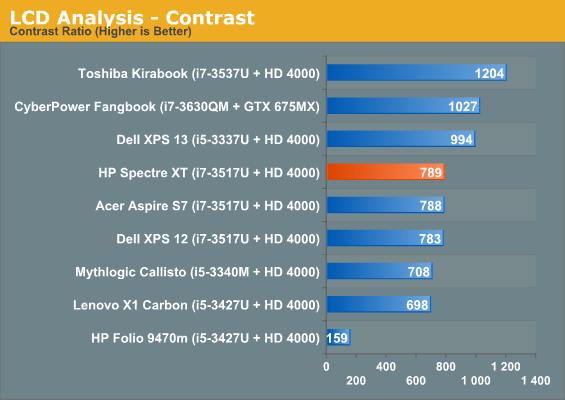
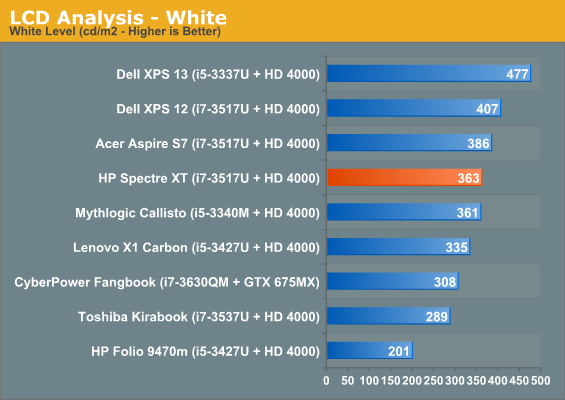
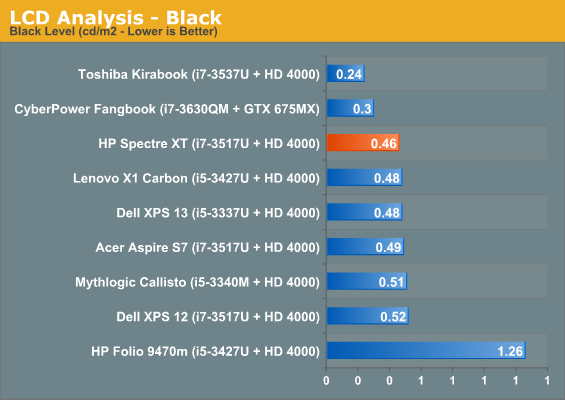
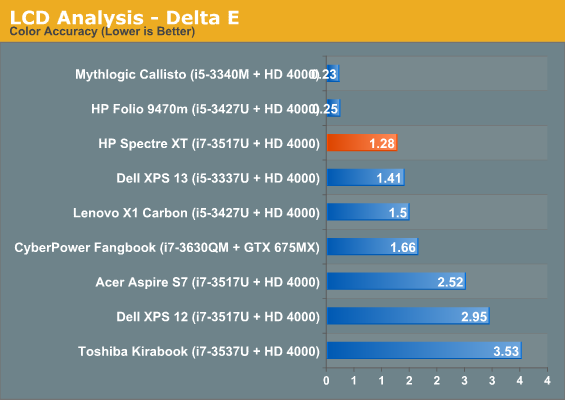
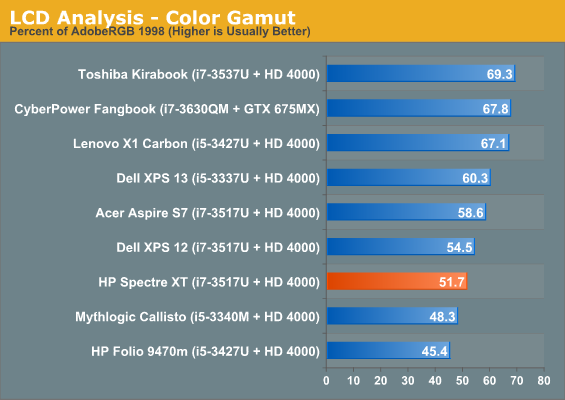

I'll take an IPS panel over a conventional TN panel any day of the week, even if it means sacrificing some of the color gamut, but it's still perplexing as to why that sacrifice is being made in the first place. Gradient testing reveals banding, but not a particularly significant amount and certainly competitive with entry-level desktop e-IPS panels. Subjectively at least, the panel on the Spectre XT is attractive and feels like where I wish notebook panels would start as opposed to being a premium item.
Battery Life
There's more bad news with the HP Spectre XT TouchSmart. HP rates the notebook for up to three hours and 45 minutes of battery life, which is a very unattractive number for a modern notebook with a 48Wh battery. Our testing unfortunately corroborates this; you can run the Spectre XT off the mains, but battery life will underwhelm.

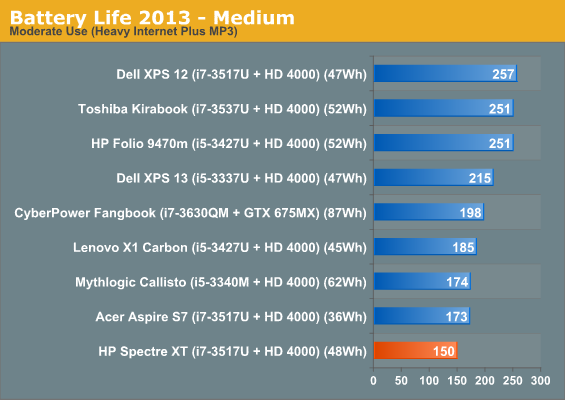
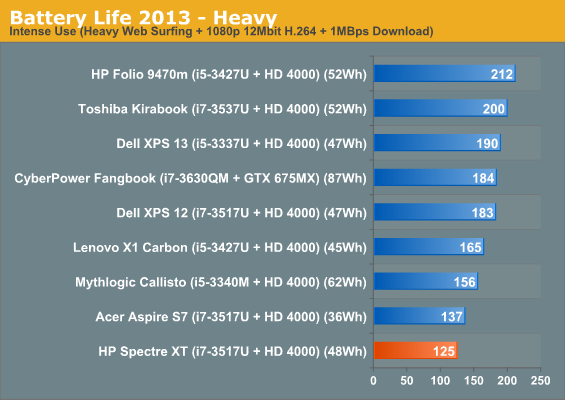
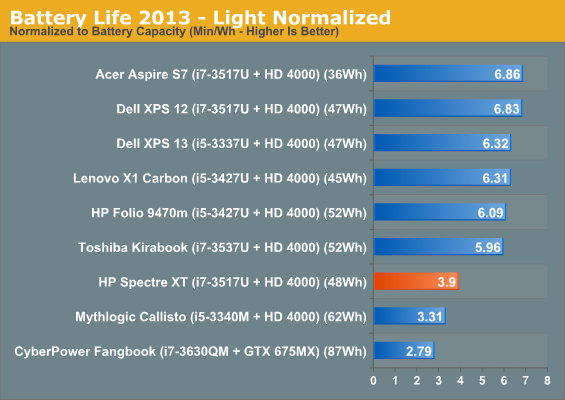
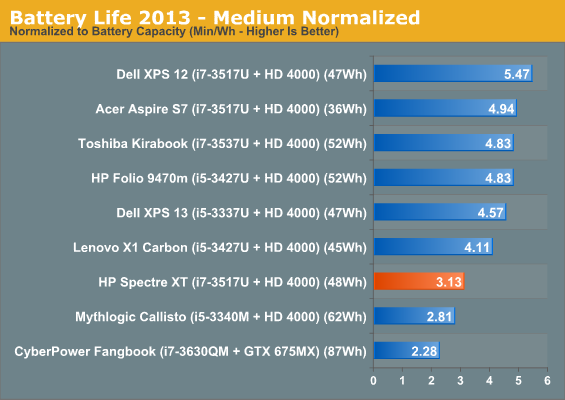
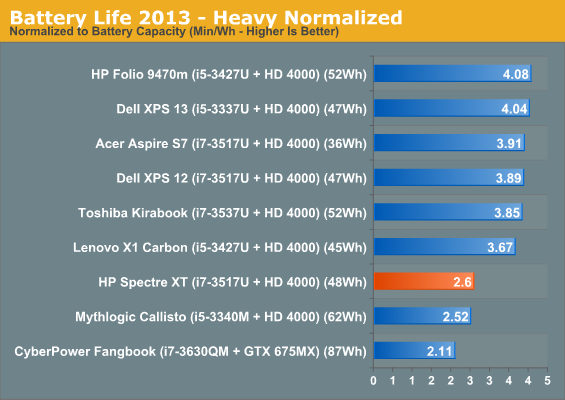
Despite the full voltage processor, Mythlogic's Callisto 1512 pulls comparable or better battery life. Part of this certainly owes to the larger battery, but it doesn't really excuse how far behind the Spectre XT's normalized battery life is by comparison. Two hours of battery life in our "heavy" test isn't just bad, it's embarrassing.
Heat and Noise
I've repeatedly cited that one of the benefits of a larger chassis, even if it's still thin, is increased cooling capacity. You can put a full voltage chip in and work the cooling system over, or you can go ULV and benefit from the increased headroom by not having to run the cooling as hard. The HP Spectre XT opts for the latter.

You can see the Spectre XT is clearly tuned for acoustics before thermals. There's a healthy amount of thermal headroom on the Ivy Bridge processor still, but I appreciate how relatively quiet the notebook is even under load.










64 Comments
View All Comments
arthur449 - Monday, May 27, 2013 - link
You're going to have to qualify your statement about the keyboard, "Typing action is pretty good, but it's about time for HP to retire or revise this design." Apart from the display, the keyboard is one of the most important aspects of a notebook computer. I've recommended HP models to my friends and family members specifically because their use-case required a typing experience that didn't leave them with the urge to (pardon the hyperbole) saw their hands off. Having a consistently competent keyboard is vastly more important, at least in my opinion, than having a newly designed one.mschira - Monday, May 27, 2013 - link
2.25kg, low voltage CPU and 2h battery life?Are they joking?
I keep saying, it's not Windows that is the problem it is the hardware makers.
Pathetic.
M.
P.S. mac 15" retina: 2.05 kg, quadcore CPU, GPU, battery life is north of 7h.
I know much more expensive, but still.
tipoo - Monday, May 27, 2013 - link
Agreed, it's very much up to the system builders. Granted, IPS displays do suck down more power, but other machines already get better battery life with one. Windows machines are perfectly capable of getting close to or above Macbook battery life, I'm not sure what stops a few of them.protomech - Monday, May 27, 2013 - link
It's not really a direct competitor to any apple product.It has the processor of a MBA, display resolution/quality between a MBA and rMBP, price of a 13" rMBP (once you add the SSD), slightly thicker/heavier vs a 15" rMBP).
Unique features are a touchscreen and terrible battery life.
mschira - Monday, May 27, 2013 - link
but comparing it to MBA will make it fare even worse when talking about battery or weight.And when talking about price, too.
M.
tipoo - Monday, May 27, 2013 - link
Just vaguely curious, if I took out the hard drive in the Spectre XT and put in my Momentus XT 750 hybrid hard drive from my old laptop, would the mSATA cache still work as normal? Would any extra setup be involved?tipoo - Monday, May 27, 2013 - link
Ah, crud, even the hard drive is not serviceable?Peskarik - Monday, May 27, 2013 - link
"Not user serviceable" - no need to read further3DoubleD - Monday, May 27, 2013 - link
I'm starting to wonder if it is possible for PC manufacturers to build a competent laptop or ultrabook. What is it that holds them back every single time?One thing I can think of is that they might not have any guarantee that they would sell very many of that model, so they need to drive their margins up to compensate for lower volume. If that is the case, what if one of the manufacturers (HP, Lenovo, ASUS, ect.) did a kickstarter-like launch. They show us the laptop (theoretical or prototype), maybe get it reviewed a couple times, then we can put our money where our mouths are. If they hit their kickstarter goal, then they can know they will be profitable with that model through economies of scale without aggressively boosting their margins by using crappy parts.
tipoo - Monday, May 27, 2013 - link
Indeed, it's the volumes and R&D and manufacturing costs. With Apple notebooks, they are guaranteed to sell well, plus they are able to get away with high margins on each. Combine the two and the company is comfortable spending a bit extra on manufacturing quality and optimization. With the likes of HP, they have so many different new models they don't know if each will be a hit, plus PCs above 1000 dollars don't sell in anywhere near mac quantities, so they have to cheap out on manufacturing and optimization to play it safe.I wish someone would just take a one time Unibody-like risk, they only had to research that once and were able to get so many years of use out of the design, and it's still arguably the best.